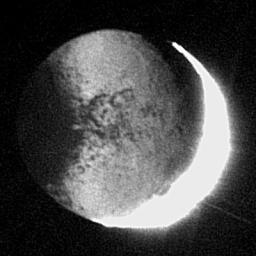It looks like you're using an Ad Blocker.
Please white-list or disable AboveTopSecret.com in your ad-blocking tool.
Thank you.
Some features of ATS will be disabled while you continue to use an ad-blocker.
share:
reply to post by eriktheawful
Earth has the most density and is the largest terrestrial planet of the four rocky planets. Water is irrelevant in that regards. I stand by my original statement of finding it odd that Earth not having the largest impact crater being that it has having the largest solid surface area.
Earth has the most density and is the largest terrestrial planet of the four rocky planets. Water is irrelevant in that regards. I stand by my original statement of finding it odd that Earth not having the largest impact crater being that it has having the largest solid surface area.
reply to post by SasquatchHunter
Water is relevant, so is the thick atmosphere and erosional processes. There are some huge craters on Earth, but they are all but invisible due to being slowly wiped off by the millions of years of geological processes like tectonics or erosion.
The largest known impact crater on Earth is the Vredefort crater, 300 km in diameter:
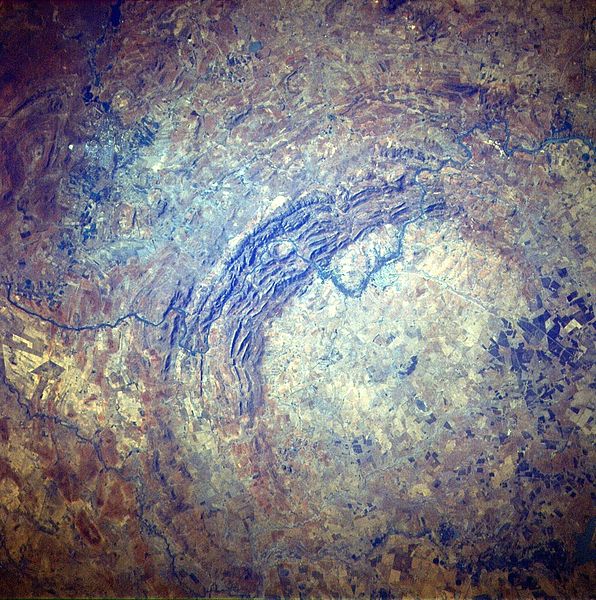
The more famous example is the Yukatan peninsula crater (called Chicxulub crater, more than 180 km in diameter, which is thought to have been responsible for the dinosaur extinction.
List of impact craters on Earth: en.wikipedia.org...
Water is relevant, so is the thick atmosphere and erosional processes. There are some huge craters on Earth, but they are all but invisible due to being slowly wiped off by the millions of years of geological processes like tectonics or erosion.
The largest known impact crater on Earth is the Vredefort crater, 300 km in diameter:

The more famous example is the Yukatan peninsula crater (called Chicxulub crater, more than 180 km in diameter, which is thought to have been responsible for the dinosaur extinction.
List of impact craters on Earth: en.wikipedia.org...
reply to post by wildespace
Again my statement is taken out of context. I said water is irrelevant in determining the total land mass of a planet. When I was "corrected" for saying Earth has the largest solid surface area that was also taking my original statement of context. Venus of course has more land above water but Earth has more landmass. Land or surface can mean different things. Debating what surface or land means was taking my original point out of context because its the only way to contest my statement. I never said water or atmosphere are irrelevant to geological features.
Again my statement is taken out of context. I said water is irrelevant in determining the total land mass of a planet. When I was "corrected" for saying Earth has the largest solid surface area that was also taking my original statement of context. Venus of course has more land above water but Earth has more landmass. Land or surface can mean different things. Debating what surface or land means was taking my original point out of context because its the only way to contest my statement. I never said water or atmosphere are irrelevant to geological features.
Glassbender777
AMAZING pics, Im somewhat taken back by the resolution of the moon.
Strange that each of the moons of saturn have a large impact crater in almost the the same position on each moon, Hmm
I wonder if those could have been caused by collisions between the moons themselves, before they settled into their orbits...
reply to post by eriktheawful
Nevermind I seen it in the OP.
-SAP-
Nevermind I seen it in the OP.
-SAP-
edit on 20-9-2013 by SloAnPainful because: (no reason given)
SasquatchHunter
reply to post by eriktheawful
Great facts about craters and moons! I enjoyed this. You would think Earth would feature the largest impact craters being the largest confirmed solid surface planet in our solar system.
Check out Hudson's Bay and the Gulf of Mexico.. those are surely massive impact craters.
reply to post by NewAgeMan
They are huge craters for sure! They are pretty wimpy compared to the ones the OP showed on Mars.
They are huge craters for sure! They are pretty wimpy compared to the ones the OP showed on Mars.
NewAgeMan
SasquatchHunter
reply to post by eriktheawful
Great facts about craters and moons! I enjoyed this. You would think Earth would feature the largest impact craters being the largest confirmed solid surface planet in our solar system.
Check out Hudson's Bay and the Gulf of Mexico.. those are surely massive impact craters.
I always thought the Hudson Bay arc was an impact, but science really says no.
Dr. Robert S. Deitz and J. Paul Barringer failed to find any of the now-recognized markers of an interstellar impact: shatter cones, unusual melted rocks such as suevite, pseudotachylite or mylonite, radial faults or fractures, signature injection breccias, or other related evidence of what geologists call “shock metamorphism”.
Source:
WebEcoist
These markers, all or most of them, are found in every impact site that we know about, and it would be impossible for none of them to be evident here, and still be an impact site. Science says that the "Nastapoka arc" is of of tectonic origin. Sometimes things quack but don't swim.
reply to post by NewAgeMan
Really who knows its possible part of the Pacific is the remnant of a colossal impact.
Awesome pic in your Sig btw.
Really who knows its possible part of the Pacific is the remnant of a colossal impact.
Awesome pic in your Sig btw.
SasquatchHunter
reply to post by NewAgeMan
They are huge craters for sure! They are pretty wimpy compared to the ones the OP showed on Mars.
Praise be to Jupiter and one super kick ass giant moon for that too. It's as if earth is better shielded from massive impacts. I wonder if the tilt of mars in it's own elliptical orbit around the sun might have been altered in the ancient past via a massive impact with a meteor or comet.
Strange that the earth has only one moon too, and by giant it's HUGE - approx 1/4 the size of the host planet.
Praise be for our giant moon, Luna, without which life as we know it would not be possible. Hallelujah?
edit on 21-9-2013 by NewAgeMan because: (no reason given)
charlyv
NewAgeMan
SasquatchHunter
reply to post by eriktheawful
Great facts about craters and moons! I enjoyed this. You would think Earth would feature the largest impact craters being the largest confirmed solid surface planet in our solar system.
Check out Hudson's Bay and the Gulf of Mexico.. those are surely massive impact craters.
I always thought the Hudson Bay arc was an impact, but science really says no.
Dr. Robert S. Deitz and J. Paul Barringer failed to find any of the now-recognized markers of an interstellar impact: shatter cones, unusual melted rocks such as suevite, pseudotachylite or mylonite, radial faults or fractures, signature injection breccias, or other related evidence of what geologists call “shock metamorphism”.
Source:
WebEcoist
These markers, all or most of them, are found in every impact site that we know about, and it would be impossible for none of them to be evident here, and still be an impact site. Science says that the "Nastapoka arc" is of of tectonic origin. Sometimes things quack but don't swim.
Thanks for clarifying.
And the Gulf of Mexico? Same thing or impact crater?
reply to post by NewAgeMan
I should have said thank Mars too for taking those hits for us, and the moon for maintaining the dynamic stabalizing fulcrum responsible for life as we know it, and shielding the earth from the occasional impact, but not like the gravity well of Jupiter which has served earth well as a type of cosmic vacuum cleaner capable of sucking in the debris before it has a chance to impact first Mars or alternatively, Earth or the moon.
It might have been what took Mars out as a planet capable of sustaining life ie: the unfavorable tilt of the planet, as compared to earth which retains a position stabilized by the steady hand of our single, giant moon.
So I'm wondering if maybe Mars might have gotten knocked off it's kilter at some point in the ancient past when liquid water flowed freely on the surface, then BAM, Mars get's impacted and thrown off it's prior tilt/axis on it's orbit around the sun - the age of the cratering might prove that out just a thought/hypothesis..
Our Strange Moon, Luna
The other thing that's strange about our moon, as distinguished from most of the other moons in our solar system is that it isn't a captured body as part of the leftover of solar system formation but instead is made up of predominantly earth-mantle material, and created or formed at about the same distance from the sun as the earth and when the "double whack" theory of lunar formation is put to the test it can't explain the present rotation of the earth or the moon's orbit and certainly can't address the "coincidence" of perfect solar eclipse, another phenomenon occurring only within the context of our moon-earth-sun relationship, and something that could only be potentially meaningful to an earth-based observer.. (bearing in mind that in ancient earth-history the moon would have appeared anywhere from 12-15 times it's visible size in the sky, being that much closer to the earth than it is today).
From what I can tell, the relationship of our moon to the formation and evolution of life on earth displays properties of a program of sorts or what is often referred to and maligned, as "intelligent design".
Dun dun dun (queue Twlight Zone music here).
Best Regards,
NAM
Illustration
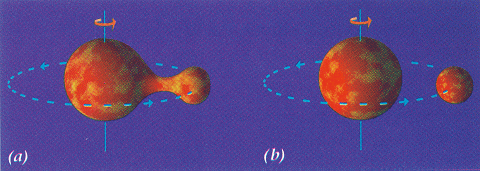
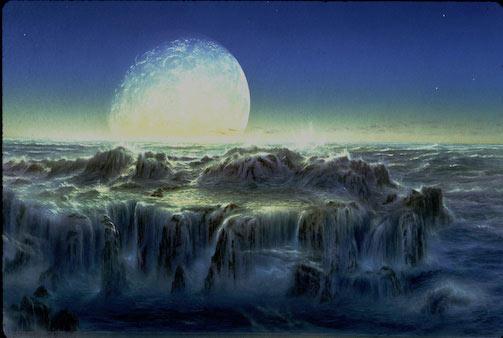
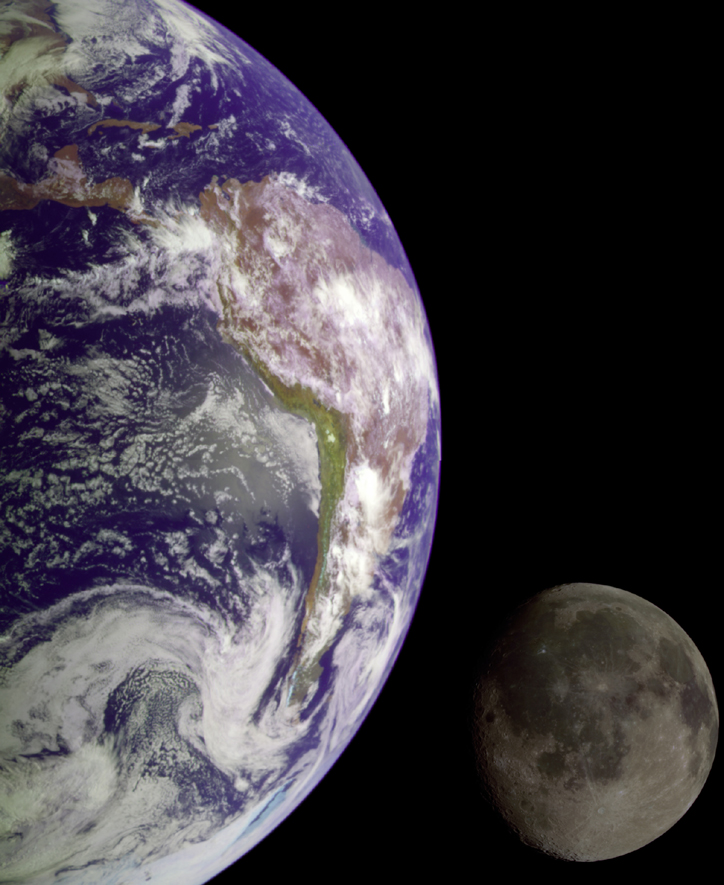
It's pretty trippy if you ask me..
Behold EARTH. It ought to be an absolute paradise, and will be hopefully with man included as it appears to have been the original intent all along, which is what makes it an extraordinary phenomenon in our own observation of it, so it IS meaningful and significant and not insignificant in the least. What a marvel!
I should have said thank Mars too for taking those hits for us, and the moon for maintaining the dynamic stabalizing fulcrum responsible for life as we know it, and shielding the earth from the occasional impact, but not like the gravity well of Jupiter which has served earth well as a type of cosmic vacuum cleaner capable of sucking in the debris before it has a chance to impact first Mars or alternatively, Earth or the moon.
It might have been what took Mars out as a planet capable of sustaining life ie: the unfavorable tilt of the planet, as compared to earth which retains a position stabilized by the steady hand of our single, giant moon.
So I'm wondering if maybe Mars might have gotten knocked off it's kilter at some point in the ancient past when liquid water flowed freely on the surface, then BAM, Mars get's impacted and thrown off it's prior tilt/axis on it's orbit around the sun - the age of the cratering might prove that out just a thought/hypothesis..
Our Strange Moon, Luna
The other thing that's strange about our moon, as distinguished from most of the other moons in our solar system is that it isn't a captured body as part of the leftover of solar system formation but instead is made up of predominantly earth-mantle material, and created or formed at about the same distance from the sun as the earth and when the "double whack" theory of lunar formation is put to the test it can't explain the present rotation of the earth or the moon's orbit and certainly can't address the "coincidence" of perfect solar eclipse, another phenomenon occurring only within the context of our moon-earth-sun relationship, and something that could only be potentially meaningful to an earth-based observer.. (bearing in mind that in ancient earth-history the moon would have appeared anywhere from 12-15 times it's visible size in the sky, being that much closer to the earth than it is today).
From what I can tell, the relationship of our moon to the formation and evolution of life on earth displays properties of a program of sorts or what is often referred to and maligned, as "intelligent design".
Dun dun dun (queue Twlight Zone music here).
Best Regards,
NAM
Illustration



It's pretty trippy if you ask me..
Behold EARTH. It ought to be an absolute paradise, and will be hopefully with man included as it appears to have been the original intent all along, which is what makes it an extraordinary phenomenon in our own observation of it, so it IS meaningful and significant and not insignificant in the least. What a marvel!
edit on 21-9-2013 by NewAgeMan because: (no reason given)
I'll bet that one of George lucas employees made the original design of the deathstar right of mimas. .
I don't know if Spielberg and Lucas were trading information . But what I know is that Spielberg had inside information about Projectt blue book.. who knows what he told George before he launched Starwars..?
I don't know if Spielberg and Lucas were trading information . But what I know is that Spielberg had inside information about Projectt blue book.. who knows what he told George before he launched Starwars..?
reply to post by eriktheawful
Very nice presentation, as usual ... thanks for posting this, Erik! The close resemblance to the death star has always been fascinating me:
Since this is ATS I do have to ask whether this similarity can really be completely coincidental!
Very nice presentation, as usual ... thanks for posting this, Erik! The close resemblance to the death star has always been fascinating me:
When seen from certain angles, Mimas resembles the Death Star (...) which is said to be roughly 140 kilometres in diameter. This stems from the fact that Herschel resembles the concave disc of the Death Star's "superlaser". This is coincidental, as the film was made nearly three years before Herschel was discovered.
Source
Since this is ATS I do have to ask whether this similarity can really be completely coincidental!
reply to post by eriktheawful
If you had to pick ONE celestial object in our solar system that you could seriously consider to be ET in design, it would most certainly be Lapetus.
It has been suggested the inner shell (core) of the 'supposed' moon is actually built from carbon nanotubes.
There's an interesting article on it here:
www.enterprisemission.com...
If you had to pick ONE celestial object in our solar system that you could seriously consider to be ET in design, it would most certainly be Lapetus.
It has been suggested the inner shell (core) of the 'supposed' moon is actually built from carbon nanotubes.
There's an interesting article on it here:
www.enterprisemission.com...
There are several areas on the Earth who's shape makes one think of impact craters. Part of the Hudson Bay was mentioned (and it's shape IS highly
suggestive):
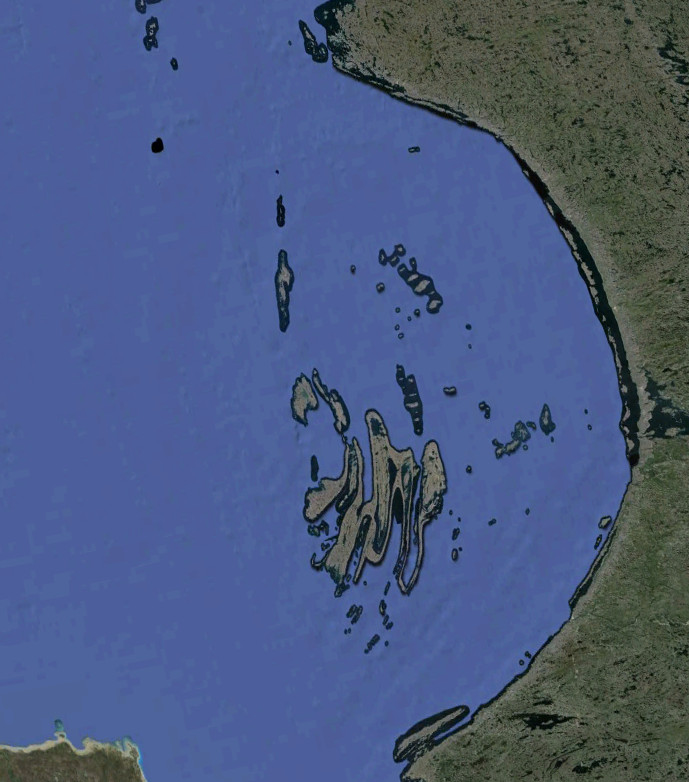
However, no conclusive proof that we normally look for is there:
1) Shocked Quartz from the sudden energy of an impact.
2) Iridium layers matching the geological time line.
However, just to the east of that area IS a impact. A Double Impact crater that has been confirmed to in fact be impact craters:
Lac a I'Eau Claire
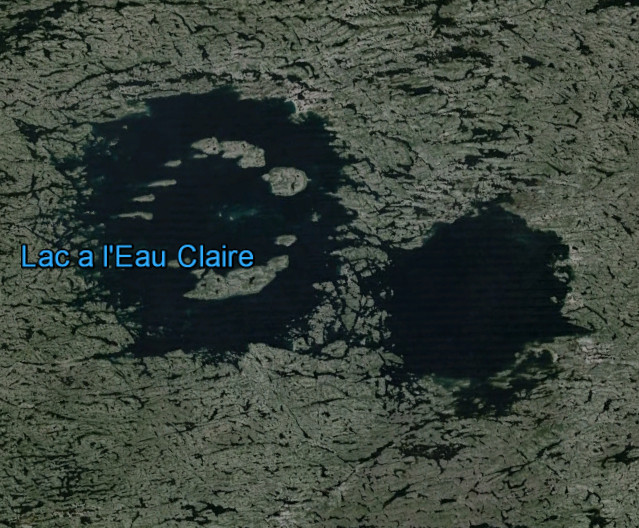
The larger one is 36 km wide, and the smaller one being 26 km wide.
You can find them on the list: List Of Impact Craters For North America
There are a lot of impact craters here on Earth that are buried. Time along with erosion from water, weather, geological processes and last but not least: Human Activity, tends to erase the visibility of many of these craters.
Here's some other suggestive impact sites (but not confirmed, etc):
Off the coast of South Carolina and North Carolina:
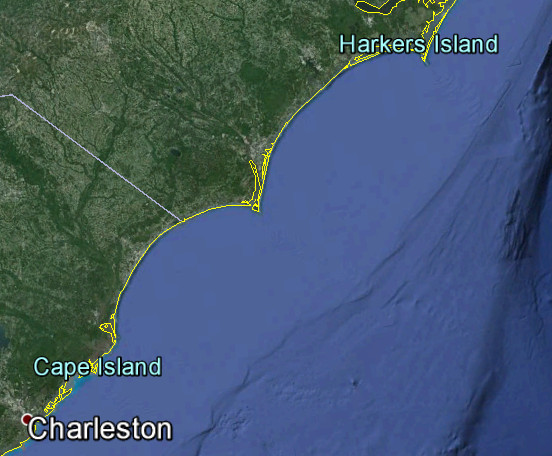
And for a dosey of one: The Sea Of Japan
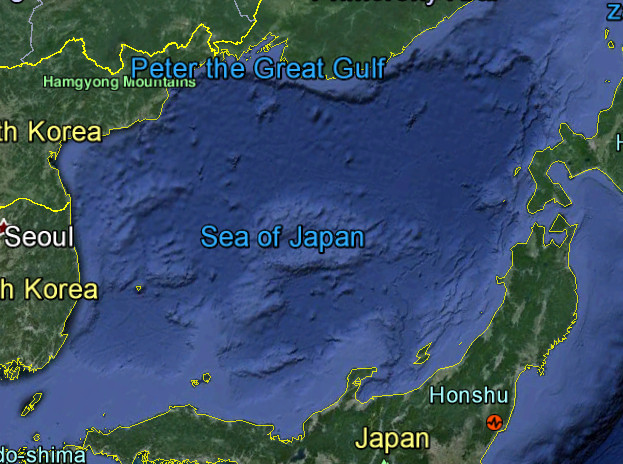

However, no conclusive proof that we normally look for is there:
1) Shocked Quartz from the sudden energy of an impact.
2) Iridium layers matching the geological time line.
However, just to the east of that area IS a impact. A Double Impact crater that has been confirmed to in fact be impact craters:
Lac a I'Eau Claire

The larger one is 36 km wide, and the smaller one being 26 km wide.
You can find them on the list: List Of Impact Craters For North America
There are a lot of impact craters here on Earth that are buried. Time along with erosion from water, weather, geological processes and last but not least: Human Activity, tends to erase the visibility of many of these craters.
Here's some other suggestive impact sites (but not confirmed, etc):
Off the coast of South Carolina and North Carolina:

And for a dosey of one: The Sea Of Japan

LadyGreenEyes
reply to post by eriktheawful
Iapetus is the one that has fascinated me for some time now. Talk about a "death star" moon! I saw one picture, with the light around it, that showed flat edges. You can see it here - NASA link
...and here is the picture -
Strange moon, that one.
Now that photo begs the question, just how did it glow like that when the other moons around Saturn have the same background light and DONT glow?
0bserver1
I'll bet that one of George lucas employees made the original design of the deathstar right of mimas. .
I don't know if Spielberg and Lucas were trading information . But what I know is that Spielberg had inside information about Projectt blue book.. who knows what he told George before he launched Starwars..?
Maybe but did they have access to the future pics of flybys of the Voyagers and no Hubble that must have happened AFTER they had made their screenplays? Or so I seem to recall.
Justoneman
LadyGreenEyes
reply to post by eriktheawful
Iapetus is the one that has fascinated me for some time now. Talk about a "death star" moon! I saw one picture, with the light around it, that showed flat edges. You can see it here - NASA link
...and here is the picture -
Strange moon, that one.
Now that photo begs the question, just how did it glow like that when the other moons around Saturn have the same background light and DONT glow?
The same way our moon did it for me.
It's called Over Exposure:
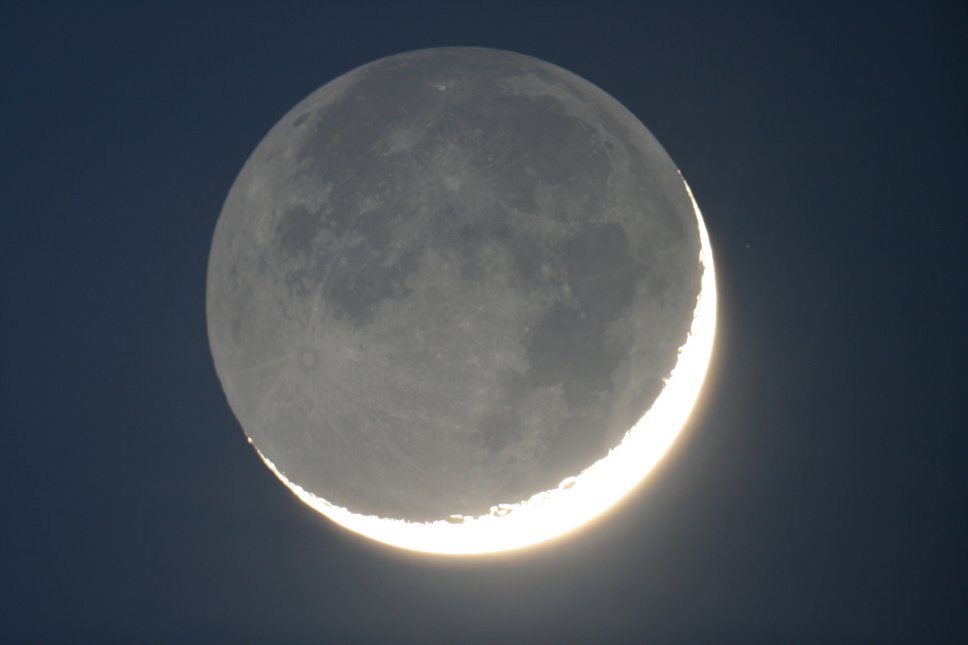
The darker part of the picture is the moon being lit up by the faint light being reflected off the Earth.
For Iapetus, it's night time side is being lit up by sun light reflected off Jupiter. To capture that, you have to over expose the frame, and when you do that, the day light side becomes very bright or over exposed.
new topics
-
Trudeau Resigns! Breaking
Other Current Events: 1 hours ago -
Live updates: Congress meets to certify Trump's presidential election victory
US Political Madness: 2 hours ago -
Gravitic Propulsion--What IF the US and China Really Have it?
General Conspiracies: 3 hours ago -
Greatest thing you ever got, or bought?
General Chit Chat: 3 hours ago
top topics
-
Sorry to disappoint you but...
US Political Madness: 17 hours ago, 17 flags -
Trudeau Resigns! Breaking
Other Current Events: 1 hours ago, 13 flags -
OK this is sad but very strange stuff
Paranormal Studies: 14 hours ago, 9 flags -
Live updates: Congress meets to certify Trump's presidential election victory
US Political Madness: 2 hours ago, 7 flags -
Islam And A Book Of Lies
Religion, Faith, And Theology: 15 hours ago, 6 flags -
Gravitic Propulsion--What IF the US and China Really Have it?
General Conspiracies: 3 hours ago, 5 flags -
Greatest thing you ever got, or bought?
General Chit Chat: 3 hours ago, 3 flags
active topics
-
Trudeau Resigns! Breaking
Other Current Events • 34 • : MindBodySpiritComplex -
Greatest thing you ever got, or bought?
General Chit Chat • 10 • : Flyingclaydisk -
-@TH3WH17ERABB17- -Q- ---TIME TO SHOW THE WORLD--- -Part- --44--
Dissecting Disinformation • 3949 • : Thoughtful3 -
Winter Storm
Fragile Earth • 42 • : Oldcarpy2 -
OK this is sad but very strange stuff
Paranormal Studies • 5 • : Ravenwatcher -
Musk calls on King Charles III to dissolve Parliament over Oldham sex grooming gangs
Mainstream News • 188 • : Oldcarpy2 -
Joe Biden gives the USA's Highest Civilian Honor Award to Hillary Clinton and George Soros.
US Political Madness • 54 • : mysterioustranger -
Speaking of Pandemics
General Conspiracies • 10 • : mysterioustranger -
Petition Calling for General Election at 564,016 and rising Fast
Political Issues • 223 • : gortex -
Gravitic Propulsion--What IF the US and China Really Have it?
General Conspiracies • 4 • : Boomer1947

